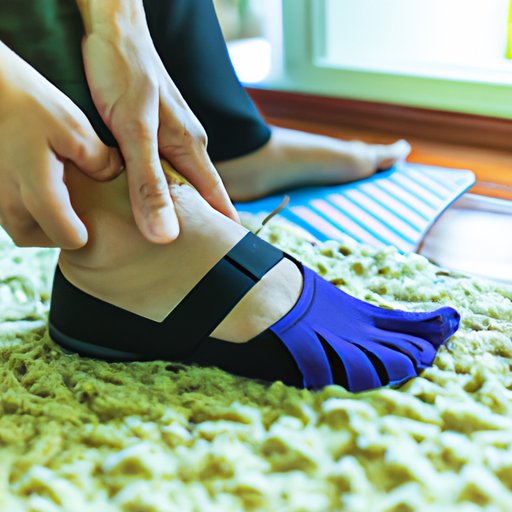Introduction
Having your toes go numb during exercise is a common problem that can be uncomfortable and even dangerous. This phenomenon, known as exercise-induced numb toes, can have several different causes. In this article, we will explore why your toes may go numb when you exercise and what you can do to prevent or minimize it.
Investigating the Causes of Exercise-Induced Numb Toes
When your toes go numb during exercise, it’s important to determine the underlying cause. There are a few possible culprits:
Poor Foot Posture and Alignment
If your feet are not properly aligned when you exercise, it can put extra strain on certain muscles and nerves. This can lead to numbness in the toes or other areas of the foot.
Overused Muscles and Joints
If you’re exercising too hard or for too long, it can put extra strain on your muscles and joints. This can lead to inflammation, which can put pressure on the nerves in your feet and cause numbness in the toes.
Poor Footwear
Wearing the wrong type of shoes while exercising can also put extra strain on your feet and cause numbness. Shoes that don’t fit correctly or don’t offer enough arch support can lead to numbness in the toes.
Nerve Compression
Nerves running through the feet can become compressed when there is tightness in the surrounding muscles or tendons. This can lead to numbness in the toes.

What to Do When Your Toes Go Numb During Exercise
If your toes go numb during exercise, there are a few things you can do to try to alleviate the symptoms:
Stretch and Massage Your Feet
Stretching and massaging the muscles in your feet can help relieve tension and reduce the likelihood of numbness. Try rolling your feet on a foam roller or using a tennis ball to massage any tight spots.
Take Breaks During Exercise
If your toes start to go numb during exercise, take a break and give your feet a rest. You can also try varying the intensity of your workout to avoid overworking your feet.
Wear Proper Footwear
Making sure you’re wearing the right type of shoes can also help reduce the risk of numb toes. Look for shoes with plenty of arch support and cushioning.

Common Exercises That Can Lead to Numb Toes
Certain types of exercise are more likely to lead to numb toes than others. These include:
Running
Running can put a lot of stress on your feet, especially if you’re running on hard surfaces or running too far or too fast. Make sure you’re wearing shoes that provide plenty of cushioning and arch support.
Cycling
Cycling can also lead to numb toes if you’re not careful. Make sure your bike is properly adjusted and that you’re wearing supportive shoes.
Weight Training
Weight training can put extra strain on your feet, particularly when doing exercises like squats, deadlifts, and lunges. Make sure you’re wearing shoes that provide plenty of support and cushioning.

Understanding How Nerve Compression Results in Numb Toes
Nerves run through the feet, providing sensation and controlling movement. If these nerves become compressed due to tight muscles or tendons, it can lead to numbness in the toes.
Tips for Minimizing Numbness in Your Toes During Exercise
If you’re prone to numb toes during exercise, there are a few steps you can take to minimize the risk:
Choose the Right Shoes
Make sure you’re wearing shoes that are comfortable and provide plenty of support and cushioning. Avoid shoes that are too tight or too loose.
Warm Up Properly
Make sure to warm up before and cool down after exercise. Warming up can help reduce the risk of numb toes by loosening the muscles and tendons in the feet.
Strengthen Supporting Muscles
Stronger muscles in the feet and lower legs can help reduce the risk of numb toes. Focus on exercises like calf raises, toe curls, and ankle circles.
Prevention Strategies for Avoiding Exercise-Related Numb Toes
There are a few strategies you can use to reduce your risk of developing exercise-induced numb toes:
Wear Supportive Shoes
Make sure you’re wearing shoes that provide plenty of arch support and cushioning. Avoid shoes that are too tight or too loose.
Stretch Before and After Exercise
Stretching before and after exercise can help reduce the risk of numb toes by loosening the muscles and tendons in the feet.
Listen to Your Body
If your toes start to go numb during exercise, take a break and give your feet a rest. Don’t push yourself too hard or for too long.
Conclusion
Exercise-induced numb toes can be an uncomfortable and even dangerous problem. Fortunately, there are a few steps you can take to reduce your risk of developing numb toes. Make sure you’re wearing supportive shoes, stretch before and after exercise, and listen to your body. With some simple precautions, you can keep your toes happy and healthy while you exercise.
(Note: Is this article not meeting your expectations? Do you have knowledge or insights to share? Unlock new opportunities and expand your reach by joining our authors team. Click Registration to join us and share your expertise with our readers.)
